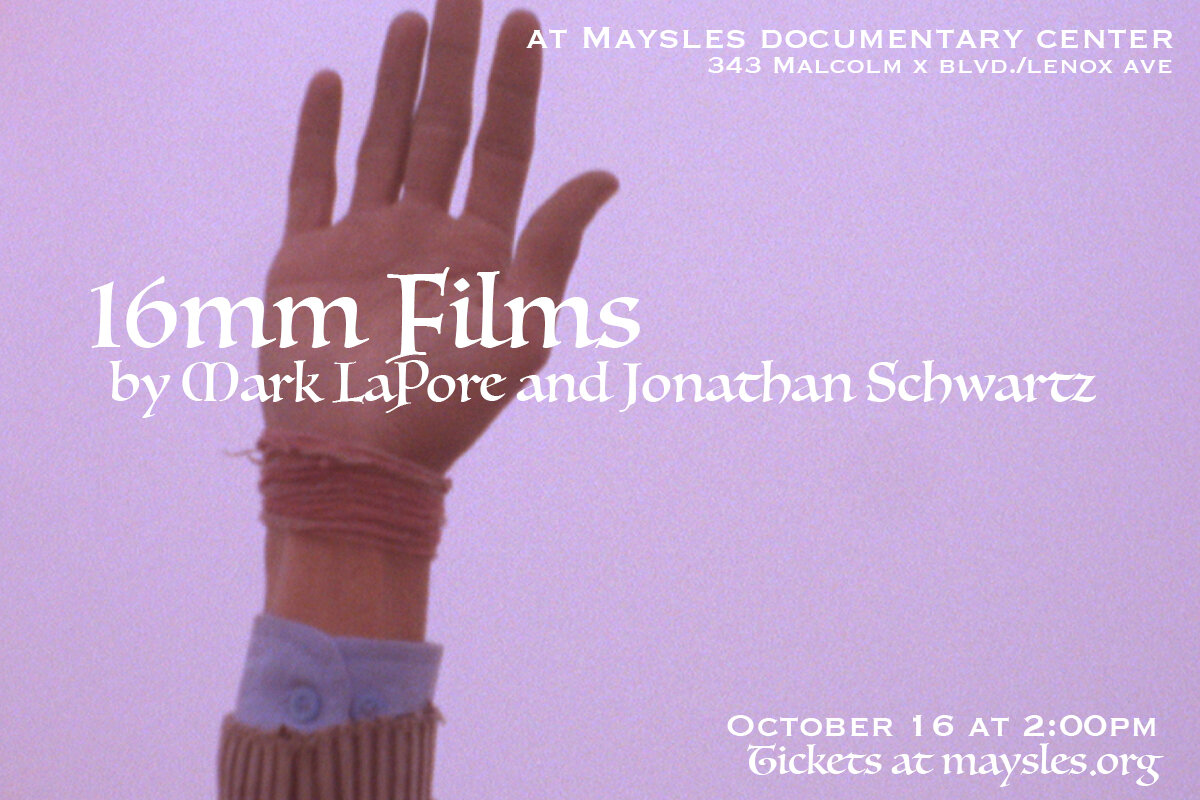16mm Films by Mark LaPore and Jonathan Schwartz is screening for $12 on October 16 at 2PM as part of A Mystery Inside a Fact: Experimental and Amateur Ethnography on the Indian Subcontinent
Maysles Documentary Center pays tribute to the work and lives of two extraordinary film artists, Mark LaPore and Jonathan Schwartz with a special 16mm presentation focused on the Bengal region. Artful, enigmatic, and breathtakingly beautiful, these films push the boundaries of the ethnographic gaze, providing an unabashedly subjective look at an often misrepresented part of the world.
16mm prints courtesy of Canyon Cinema.
Film Include:
A Mystery Inside of a Fact (Jonathan Schwartz, 2016, 17 min)
“It arrives, in a fog, with songs, through dance or majestic animals or faces (gliding on the street), and in shapes of light, maybe on a large bird of prey in flight--gesture skyward. Some origins can be difficult to pinpoint, others blink back--infinitely.” - Jonathan Schwartz
Den of Tigers (Jonathan Schwartz, 2002, 19 min)
"an invitation to walk look listen. West Bengal, India. collected, or pretend to." - Jonathan Schwartz
A Depression in the Bay of Bengal (Mark LaPore, 1986, 28 min)
“A Depression in the Bay of Bengal is a 28-minute color film shot while on a Fulbright Scholars Fellowship to Sri Lanka in 1993-1994. I went to Sri Lanka with the idea that I would remake Basil Wright's and John Grierson's 1934 documentary Song of Ceylon. After spending three months there I realized just how impossible that would be. Wright's film was formally innovative and visually brilliant but his experience was not to be revisited. Each of the places he filmed still exist, but thirteen years of ethnic war have colored the way in which those places can be portrayed. I have made a film about travelling and living in a distant place which looks at aspects of daily life and where the war shadows the quotidian with a dark and rumbling step.
This film is both diaristic and metaphorical, both on account of my observations of everyday life as well as an indirect record of the war and of the tense atmosphere which permeates life there. The overwhelming sensation in the film is that of both physical and metaphorical distance: the distance between the traveler and Sri Lankans, the miles traveled as indicated by the persistent sound of trains, the distance between the camera and the subject, time as distance as evoked both by the historical footage and the notion of trains as a nineteenth century mode of transport, and by the black leader at the close of the film over which an article about an explosion in Sri Lanka is read. Past experience, whether local or far away, exists only in the mind and for the duration of the last three minutes of the film, mental images are the ones that play on the screen.” - Mark LaPore
The Glass System (Mark LaPore, 2000, 20 min)
“The Glass System, made from images shot in New York and Calcutta, looks at life as it is played out in the streets. Every corner turned reveals activities both simple and unfamiliar: a knife sharpener on a bicycle; a tiny tightrope walker; a man selling watches in front of a department store on Fifth Avenue; a hauntingly slow portrait of the darting eyes of schoolgirls on their way home; the uncompleted activities of a young contortionist. The sound in the film (which is from a Bengali primer written by British missionaries) is a meditation on how the English language teaches ideas about culture which are often incongruous. The disjunction between what you hear and what you see evokes reflections about the impact of globalization and the hegemony of Western-style capitalism.” - Mark LaPore
Kolkata (Mark LaPore, 2005, 35 min)
“A portrait of North Kolkata (Calcutta), this film searches the streets for the ebb and flow of humanity and reflects the changing landscape of a city at once medieval and modern." - Mark LaPore










